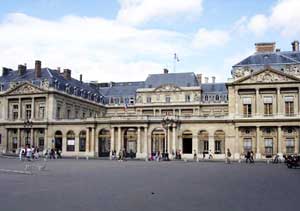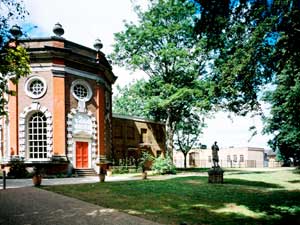“Secrecy is the first essential in affairs of state.” — Cardinal Richelieu (1585-1642).
Cardinal Richelieu was a man who led a hugely influential and at times controversial life and among the many marks he left on French society is the Palais Royal.
A man who thrived on scheming and secrecy it comes as no surprise that the palace he built, and more importantly the gardens, should play a vital role in Parisian history.

Built for Cardinal Richelieu by Jacques Lemercier, this building and its large adjoining garden were once known as the Palais Cardinal. The construction was finished in 1642 but the Cardinal died the same year and the palace became the property of the crown and acquired the name Palais Royal.
Having become property of the French crown, the Palais Royal was to know a long string of royal yet contentious guests.
After the death of Louis XIII, the Queen Mother, Anne of Austria, her advisor and her young sons, King Louis XIV and Philippe, duc d'Anjou all moved into the palace.
During the Fronde, a civil war which led to the dismantling of territorial aristocracy and the emergence of absolute monarchy, the royal family used the Palais Royal as an escape.
From 1649, the palace played host to more royals fleeing from civil war, but this time it was the Queen of England, Henrietta-Maria of France. She arrived at the Palais Royal with her youngest daughter Henrietta-Anne in tow and then never really left.
As the wife of King Charles I of England, she was left impoverished upon his execution and so lived off the generosity of her nephew, Louis XIV. Henrietta-Anne secured her fate in 1661 by marrying the King's younger brother, Phillipe de France, duc d'Orléans.

The marriage in 1661 marked the palace as the premier residence of the House of Orléans. It also signified the re-birth of the Palais Royal as the focal point of court gatherings.
The young couple were ill-suited: Henrietta-Anne was an insatiable flirt (even rumoured to have had a fling with the King, her husband's brother) and Philippe made no effort to hide his homosexuality. Although far from being a match made in heaven, the Duke and Duchess of Orléans had one thing in common: socialising.
So that is what they did.
The Palais Royal became the center of the social world, famed throughout France as the place where the crème de la crème of society wanted to be seen.
Upon the death of Henrietta-Anne in 1670 (she was allegedly poisoned by her husband and his lover) there was a dip in the palace's popularity as Philippe moved out with his new wife. In 1692 the new Duke and Duchess d'Orléans moved back into the Palais Royal and it was given a new lease of life. The lavish parties started up again and the palace regained the status it once had.
In 1784, the gardens and buildings of the Palais Royal were opened up to the public and found immediate popularity.
The arcades were full of boutiques, cafés, hair salons, bookshops and museums and more importantly they attracted the aristocracy, the middle classes, and the lower orders. This mixing of social classes was a revelation and the palace soon gained a reputation as being the hot-bed of discussion and liberated thinking in Paris.
Philippe Égalité opened the gardens of the Palais Royal to the public but prohibited access to the police. This level of freedom could not be found anywhere else in Paris so the gardens became a Mecca for intellectuals and artists.
The Bastille would fall nonotheless. Sadly Philippe, despite his support for the Revolution, didn't manage to escape the blood thirsty orchestrators of the Grand Terror and he was guillotined.
The palace was the victim of a slightly kinder fate although it was pillaged during the Worker's Revolution and set fire to in 1872.
Today the Palais Royal is home to the Constitutional Council and the Ministry of Culture but Philippe's arcades are still bustling with shops and cafés.